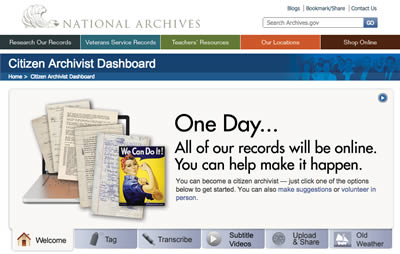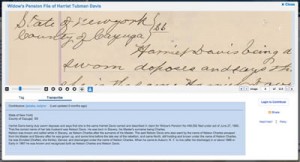
The Citizen Archivist Dashboard.

The Citizen Archivist Dashboard.
The National Archives is a treasure trove of historical records that citizens can use to discover and learn. But finding something in the National Archives can be like trying to find a needle in a haystack. With more than 12 billion pages of paper records alone, the National Archives and Records Administration has no shortage of records to digitize or transcribe.
Capitalizing on widespread public interest in its national records, NARA launched a project to recruit “citizen archivists,” a term coined in 2010 to describe how volunteers can contribute to the National Archives by making records more accessible online. The Citizen Archivist Dashboard is NARA’s online portal for engaging the public in projects that help make records easier to find online.
Download this case study (PDF, 72KB)
Website: Citizen Archivist Dashboard
Through the Citizen Archivist Dashboard, NARA is leveraging the power of the crowd to contribute through online tools, in-person events and external communities. NARA’s crowdsourcing initiatives include engaging volunteers in tagging archival records, transcribing documents, subtitling historical videos, editing Wiki articles, and indexing weather observations from ship logs.

Sample transcription in the National Archives Catalog, a page in the Widow’s Pension File of Harriet Tubman Davis.
Volunteers who transcribe records are helping to unlock the information contained within the digital scans of historical documents. Volunteers also tag records, which is a fun and easy way for participants to make records more accessible to users. By adding keywords, terms and labels to a record, a volunteer makes it easier to find online. Both transcription and tagging tasks are available in the National Archives Catalog, a resource of more than 2.5 million pages of records.
In order to reach a broad range of volunteers with diverse interests, the Citizen Archivist Dashboard highlights a wide variety of records. Volunteers can work on the handwritten Civil War pension file of Harriet Tubman or tag the photographs of Matthew Brady. They can transcribe presidential records, including the menus of President Truman, and help tag photographs from the National Aeronautics and Space Administration or the Environmental Protection Agency.
The Citizen Archvist Dashboard uses both NARA-run platforms and external platforms. Volunteers can subtitle and translate historical videos from the National Archives on Amara, tag images on Flickr, index weather observations on Oldweather.org, and help improve Wikipedia’s coverage of topics related to the National Archives using WikiProject NARA.
With billions of records to manage, NARA has to design crowdsourcing activities that do not put additional strain on limited staff resources. Focusing on transcribing and tagging records allows NARA to utilize public contributions easily and without significant review by staff members.
Since 2012, citizens have contributed millions of tags, metadata, transcriptions, video subtitles and digital images. To celebrate Sunshine Week 2015, the National Archives launched a Transcription Challenge. In one week, the public transcribed 2,500 pages and added 10,000 tags to records in the National Archives Catalog. And through NARA’s collaboration with Wikipedia, the records of the National Archives have been incorporated into more than 4,000 Wikipedia articles, which receive more than 1 billion page views annually.
The Citizen Archivist Dashboard is also an early story of success that legitimized crowdsourcing in federal agencies. In 2012 it was recognized as one of the Top 25 Innovations in Government by the Ash Center for Democratic Governance and Innovation at Harvard University’s Kennedy School of Government.
The Citizen Archivist Dashboard was expanded in 2015 to include transcription and tagging of records within the National Archives Catalog. These new features allow anyone from the public to contribute to millions of pages of historical records and track their contributions. In seven months, the public has contributed more than 20,000 pages of transcriptions and 40,000 tags. This increased public engagement has added significant metadata that improves search results for the public by unlocking the information contained within the records.
The Citizen Archivist Dashboard case study illustrates the following steps in the Federal Citizen Science and Crowdsourcing Toolkit:
Andrew Wilson
Email: andrew.wilson@nara.gov